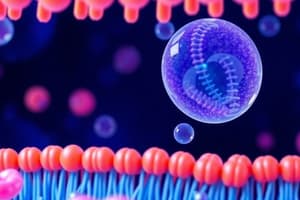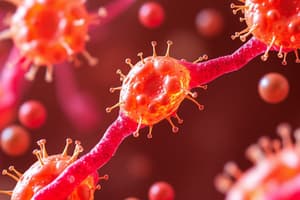Podcast
Questions and Answers
What are the three major groups of components of a cell membrane?
What are the three major groups of components of a cell membrane?
- Proteins, Glycolipids, Carbohydrates
- Proteins, Lipids, Carbohydrates (correct)
- Carbohydrates, Lipids, Polymers
The lipid bilayer provides the basic structure of the cell membrane.
The lipid bilayer provides the basic structure of the cell membrane.
True (A)
Which of the following is NOT a phospholipid?
Which of the following is NOT a phospholipid?
- Cephalin
- Cholesterol (correct)
- Lecithin
- Sphingomyelin
Cholesterol is found in both prokaryotes and eukaryotes.
Cholesterol is found in both prokaryotes and eukaryotes.
What is the function of the phospholipid bilayer?
What is the function of the phospholipid bilayer?
Which of the following molecules are found in the hydrophilic head of a phospholipid?
Which of the following molecules are found in the hydrophilic head of a phospholipid?
Phospholipids are amphiphilic.
Phospholipids are amphiphilic.
What are the two primary categories of membrane proteins?
What are the two primary categories of membrane proteins?
Which type of membrane protein can be found entirely embedded within the membrane?
Which type of membrane protein can be found entirely embedded within the membrane?
What type of function do peripheral proteins typically serve?
What type of function do peripheral proteins typically serve?
Oligosaccharides can be found attached to both lipids and proteins.
Oligosaccharides can be found attached to both lipids and proteins.
Which of the following is NOT a function of oligosaccharides on the cell membrane?
Which of the following is NOT a function of oligosaccharides on the cell membrane?
The most important monosaccharide components of the cell membrane are:
The most important monosaccharide components of the cell membrane are:
The cell membrane is a dynamic structure.
The cell membrane is a dynamic structure.
What is the function of the cell membrane?
What is the function of the cell membrane?
The cell membrane can not move.
The cell membrane can not move.
What is the function of flippase and floppase proteins?
What is the function of flippase and floppase proteins?
The cell membrane can be damaged, leading to cell death.
The cell membrane can be damaged, leading to cell death.
What is the function of lipid rafts?
What is the function of lipid rafts?
All cell membranes are identical.
All cell membranes are identical.
What is the primary event in cell death that leads to cell death?
What is the primary event in cell death that leads to cell death?
The cell membrane is composed of two identical lipid monolayers.
The cell membrane is composed of two identical lipid monolayers.
What is the role of carbohydrates in the cell membrane?
What is the role of carbohydrates in the cell membrane?
The fluid mosaic model was proposed in 1972 and is still the most widely accepted model for the cell membrane.
The fluid mosaic model was proposed in 1972 and is still the most widely accepted model for the cell membrane.
Membrane fluidity (elasticity) is increased by:
Membrane fluidity (elasticity) is increased by:
Lipid rafts play an important role in cellular processes, including membrane transport, fluidity, signal transduction, and neurotransmission.
Lipid rafts play an important role in cellular processes, including membrane transport, fluidity, signal transduction, and neurotransmission.
The cell membrane only acts as a barrier to regulate the flow of molecules and ions, not as a metabolic compartment with unique functions.
The cell membrane only acts as a barrier to regulate the flow of molecules and ions, not as a metabolic compartment with unique functions.
The cell membrane is symmetrical.
The cell membrane is symmetrical.
Which of the following is NOT a factor that influences the fluidity of the cell membrane?
Which of the following is NOT a factor that influences the fluidity of the cell membrane?
Flashcards
Prokaryotic Cell
Prokaryotic Cell
A cell without a nucleus, including bacteria. Generally small and unicellular.
Eukaryotic Cell
Eukaryotic Cell
A cell with a nucleus, including animal, plant, and fungal cells. Can be unicellular or multicellular.
Cell Membrane
Cell Membrane
The biological membrane that separates the cell interior from the external environment.
Plasma Membrane
Plasma Membrane
Signup and view all the flashcards
Internal Membranes
Internal Membranes
Signup and view all the flashcards
Lipid Bilayer
Lipid Bilayer
Signup and view all the flashcards
Phospholipids
Phospholipids
Signup and view all the flashcards
Glycerolphosphatides
Glycerolphosphatides
Signup and view all the flashcards
Hydrophobic Tail
Hydrophobic Tail
Signup and view all the flashcards
Hydrophilic Head
Hydrophilic Head
Signup and view all the flashcards
Cholesterol
Cholesterol
Signup and view all the flashcards
Sphingolipids
Sphingolipids
Signup and view all the flashcards
Sphingomyelin
Sphingomyelin
Signup and view all the flashcards
Ceramide
Ceramide
Signup and view all the flashcards
Saturated Fatty Acid
Saturated Fatty Acid
Signup and view all the flashcards
Unsaturated Fatty Acids
Unsaturated Fatty Acids
Signup and view all the flashcards
Lecithin
Lecithin
Signup and view all the flashcards
Cephalin
Cephalin
Signup and view all the flashcards
Phosphatidic acid
Phosphatidic acid
Signup and view all the flashcards
Carbohydrates in the Membrane
Carbohydrates in the Membrane
Signup and view all the flashcards
Study Notes
Cell Membrane
- A cell membrane is the barrier between a cell and its environment. It's made up of a variety of components, but primarily lipids, proteins, and carbohydrates.
Prokaryotes and Eukaryotes
- Prokaryotes:
- Bacteria are prokaryotes
- Generally very small and unicellular.
- Earliest and most abundant life forms, evolved about 4 billion years ago.
- Some species are highly evolved pathogens.
- Eukaryotes:
- Include animals, plants, and fungi.
- Some are unicellular and some are multicellular.
- Evolved about 1 billion years ago.
- Size ranges differ from prokaryotes.
- Contain a nucleus (not present in prokaryotes).
- Diagrams of both prokaryotic and eukaryotic cells with their component labels are presented.
Eukaryotic Cell Membranes
- Plasma membrane: Forms the outer barrier between the cell and its environment.
- Internal membranes: Separate the subcellular organelles from the cytoplasm.
- The thickness of subcellular membranes is 6-10nm.
Cell (Biological) Membrane Components
- Lipids (40%):
- Lipid bilayer structure, mostly composed of phospholipids.
- Includes sphingomyelin, lecithin, cephalin, and cholesterol.
- Cholesterol is found only in eukaryotes.
- Proteins (60%):
- Integrated into the lipid bilayer or on the membrane surface.
- Includes integral and peripheral proteins.
- Also includes glycoproteins and glycolipids.
- Carbohydrates (less than 1%):
- Usually branched oligosaccharides that are primarily bonded to lipids (glycolipids) or proteins (glycoproteins).
Membrane Lipid Components
- Phospholipids: Major components of cell membranes; have a glycerol backbone.
- Glycerolphosphatides: Subtype of phospholipid with a glycerol backbone.
- Saturated vs Unsaturated fatty acids: Different types of fatty acids in phospholipids affect the fluidity of membrane
- Amphipathic molecules: Phospholipids have a hydrophobic (water-fearing) tail and a hydrophilic (water-loving) head.
- Cholesterol: A steroid lipid that's found in animal cell membranes and interspersed among phospholipid tails; it affects membrane fluidity.
- Sphingolipids:
- Sphingosine (18-carbon amino alcohol) with an unsaturated hydrocarbon chain.
- Ceramides: Sphingosine bonded to fatty acid (amide bond).
- Sphingomyelin: Ceramide and phosphate groups joined (ester bond).
Membrane Protein Types
- Integral proteins:
- Transmembrane proteins with hydrophobic regions spanning the membrane interior.
- Hydrophilic ends are exposed to the intracellular and extracellular environments.
- Can serve as ion channels.
- Often relatively mobile in the membrane and can be immobile from cytoskeleton binding.
- Peripheral proteins:
- Not embedded in the lipid bilayer, loosely bound to the membrane surface or to integral proteins.
- Often play static roles in the membrane, such as receptors.
Membrane Carbohydrate Components
- Vary among species, individuals within species, cell types, etc.
- Function as markers that distinguish one cell from another.
- Involved in cell-cell interactions, immune responses, and binding to other molecules.
- Includes monosaccharides (Glucose, Mannose, Galactose, Fucose), and oligosaccharides.
- Many are covalently bonded to lipids (glycolipids) or proteins (glycoproteins) to form more complex structures.
Movement of Membrane Lipids
- Rotation: Lipids rotate freely within their monolayer.
- Lateral diffusion: Lipids move laterally within their monolayer.
- Transversal diffusion ("flip-flop"): Lipids transfer from one monolayer to the other. Energy-dependent and uses specific proteins (flippase, floppase, scramblase).
Membrane Fluidity
- Membrane fluidity depends on several factors that affect fatty acid composition and cholesterol content.
- Temperature, the proportion of unsaturated fatty acids and amount of cholesterol are important considerations in determining fluidity.
Lipid Rafts
- Cholesterol & sphingolipids form microdomains called rafts, which are more ordered regions affecting cellular process like transmembrane transport, signal transduction, and neurotransmission.
Importance and Function of the Biological Membrane
- Cell membranes are selective barriers that regulate the transport of molecules across them, control the environments of compartments, and define the metabolism of those compartments.
Membrane Assymetry
- Two lipid layers of the cell membrane differ from each other in phospholipid type which leads to the asymmetrical structure.
- Carbohydrates are primarily found on the extracellular face of the membrane.
- Membrane proteins and lipids each have a directional orientation, meaning they have an outside and inside face, too.
Studying That Suits You
Use AI to generate personalized quizzes and flashcards to suit your learning preferences.




